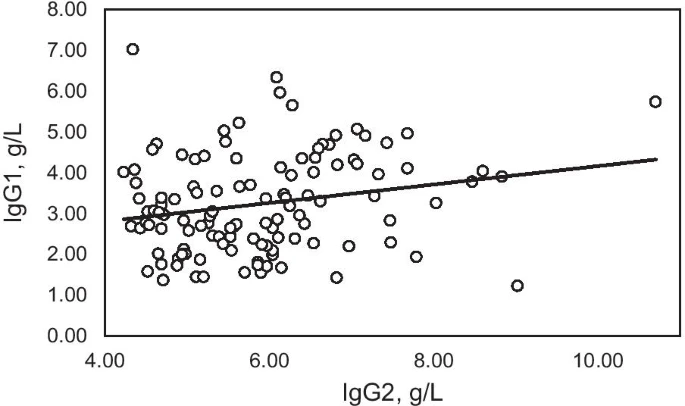- Research
- Open Access
- BMC Immunology
Factors associated with IgG levels in adults with IgG subclass deficiency (IgGSD) are incompletely understood. We studied adults with IgGSD with subnormal IgG1 only, subnormal IgG1/IgG3, or subnormal IgG3 only without other subnormal IgG subclasses, IgA, or IgM. We compiled: age; sex; autoimmune condition(s) (AC); atopy; IgG, IgG subclasses, IgA, IgM; IgGsum (IgG1 + IgG2 + IgG3 + IgG4); and D (percentage difference between IgGsum and IgG).
We compared attributes of patients with/without subnormal IgG (< 7.00 g/L; subnormal IgG1 subclass groups only) and analyzed IgGsum and IgG relationships. We performed backward stepwise regressions on IgG using independent variables IgG subclasses, age, and sex and on D using independent variables age and sex.There were 39 patients with subnormal IgG1 only (89.7% women), 53 with subnormal IgG1/IgG3 (88.7% women), and 115 with subnormal IgG3 only (91.3% women). Fifteen patients (38.5%) and 32 patients (60.4%) in the respective subnormal IgG1 subclass groups had subnormal IgG. Attributes of patients with/without IgG < 7.00 g/L were similar, except that AC prevalence was lower in patients with subnormal IgG1 only and IgG < 7.00 g/L than ≥ 7.00 g/L (p = 0.0484). Mean/median IgG1 and IgG2 were significantly lower in patients with IgG < 7.00 g/L in both subnormal IgG1 subclass groups (p < 0.0001, all comparisons). Regressions on IgG in three subclass groups revealed positive associations with IgG1 and IgG2 (p < 0.0001 each association). Regressions on D revealed no significant association. IgG1 percentages of IgGsum were lower and IgG2 percentages were higher in patients with subnormal IgG1 subclass levels than subnormal IgG3 only (p < 0.0001 all comparisons).
We conclude that both IgG1 and IgG2 are major determinants of IgG in patients with subnormal IgG1, combined subnormal IgG1/IgG3, or subnormal IgG3 and that in patients with subnormal IgG1 or combined subnormal IgG1/IgG3, median IgG2 levels are significantly lower in those with IgG < 7.00 g/L than those with IgG ≥ 7.00 g/L.

No comments:
Post a Comment